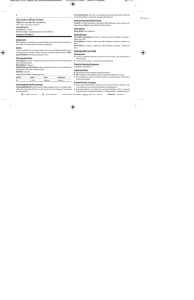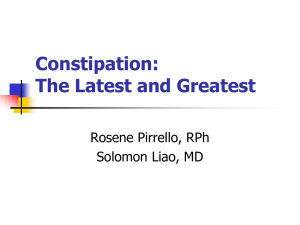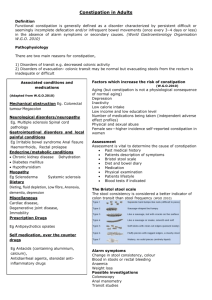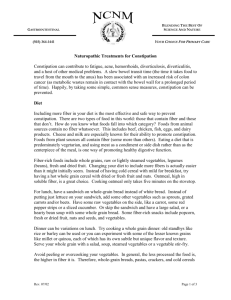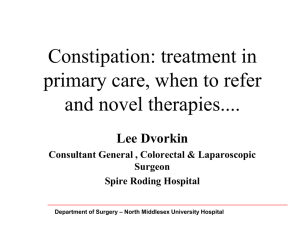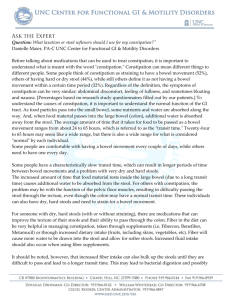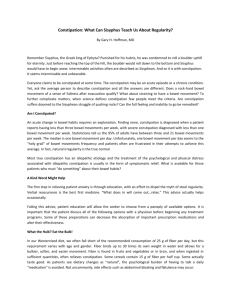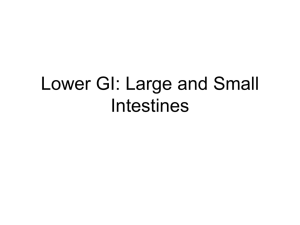DRUGS AFFECTING MOTILITY OF THE GI TRACT CENTRALLY
advertisement
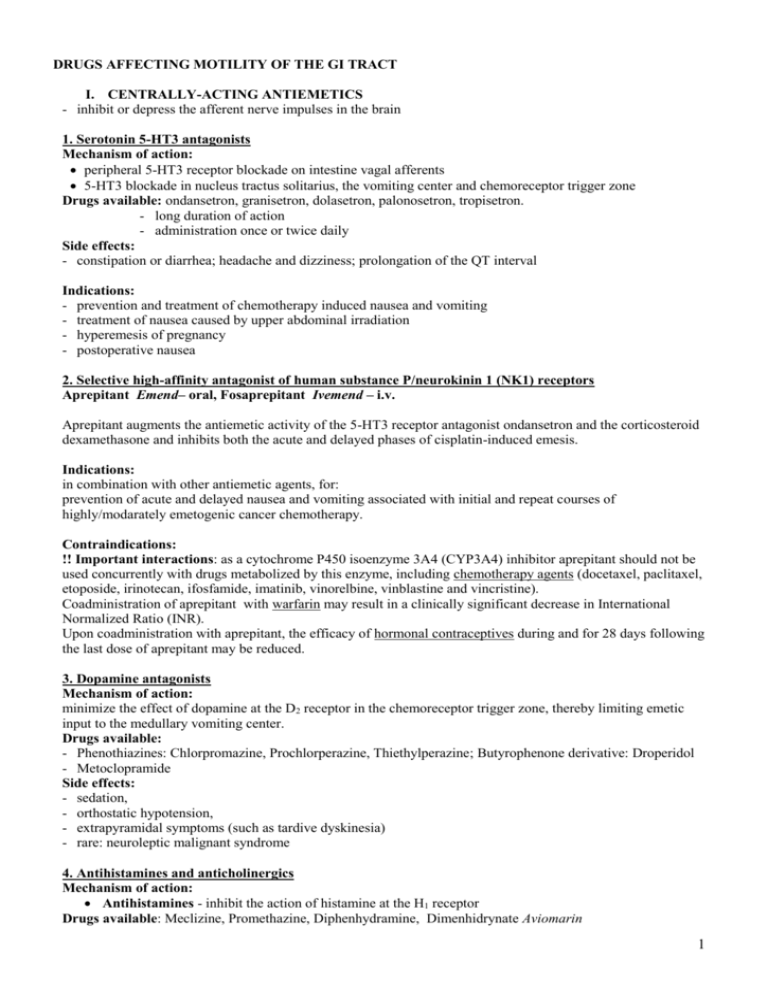
DRUGS AFFECTING MOTILITY OF THE GI TRACT I. CENTRALLY-ACTING ANTIEMETICS - inhibit or depress the afferent nerve impulses in the brain 1. Serotonin 5-HT3 antagonists Mechanism of action: peripheral 5-HT3 receptor blockade on intestine vagal afferents 5-HT3 blockade in nucleus tractus solitarius, the vomiting center and chemoreceptor trigger zone Drugs available: ondansetron, granisetron, dolasetron, palonosetron, tropisetron. - long duration of action - administration once or twice daily Side effects: - constipation or diarrhea; headache and dizziness; prolongation of the QT interval Indications: - prevention and treatment of chemotherapy induced nausea and vomiting - treatment of nausea caused by upper abdominal irradiation - hyperemesis of pregnancy - postoperative nausea 2. Selective high-affinity antagonist of human substance P/neurokinin 1 (NK1) receptors Aprepitant Emend– oral, Fosaprepitant Ivemend – i.v. Aprepitant augments the antiemetic activity of the 5-HT3 receptor antagonist ondansetron and the corticosteroid dexamethasone and inhibits both the acute and delayed phases of cisplatin-induced emesis. Indications: in combination with other antiemetic agents, for: prevention of acute and delayed nausea and vomiting associated with initial and repeat courses of highly/modarately emetogenic cancer chemotherapy. Contraindications: !! Important interactions: as a cytochrome P450 isoenzyme 3A4 (CYP3A4) inhibitor aprepitant should not be used concurrently with drugs metabolized by this enzyme, including chemotherapy agents (docetaxel, paclitaxel, etoposide, irinotecan, ifosfamide, imatinib, vinorelbine, vinblastine and vincristine). Coadministration of aprepitant with warfarin may result in a clinically significant decrease in International Normalized Ratio (INR). Upon coadministration with aprepitant, the efficacy of hormonal contraceptives during and for 28 days following the last dose of aprepitant may be reduced. 3. Dopamine antagonists Mechanism of action: minimize the effect of dopamine at the D2 receptor in the chemoreceptor trigger zone, thereby limiting emetic input to the medullary vomiting center. Drugs available: - Phenothiazines: Chlorpromazine, Prochlorperazine, Thiethylperazine; Butyrophenone derivative: Droperidol - Metoclopramide Side effects: - sedation, - orthostatic hypotension, - extrapyramidal symptoms (such as tardive dyskinesia) - rare: neuroleptic malignant syndrome 4. Antihistamines and anticholinergics Mechanism of action: Antihistamines - inhibit the action of histamine at the H1 receptor Drugs available: Meclizine, Promethazine, Diphenhydramine, Dimenhidrynate Aviomarin 1 Anticholinergic agents - inhibit the action of acetylcholine at the muscarinic receptor Drugs available: Scopolamine Indications: - nausea and vomiting caused by stimulation of the vomiting center from the vestibular system (motion sickness) - postoperative emesis Side effects: - confusion, sedation, dizziness, tinnitus, insomnia, incoordination, fatigue, and tremors (meclizine) - Both antihistamines and anticholinergics - anticholinergic side effects - dry mouth, - urinary retention, - blurred vision, - exacerbation of narrow-angle glaucoma. 5. Cannabinoids - antiemetic psychoactive substances derived from marijuana - available as the medications in the US, Canada, Germany, Netherlands Drugs available: dronabinol – synthetic tetrahydrocannabinol THC Marinol (USA), Sativex mouth spray (Canada) nabilone Cesamet (Canada) Mechanism of action: Dronabinol is an orally active cannabinoid which, like other cannabinoids, has complex effects on the central nervous system (CNS), including central sympathomimetic activity. Cannabinoid receptors have been discovered in neural tissues. Tachyphylaxis and tolerance do not, however, appear to develop to the appetite stimulant effect of MARINOL (dronabinol). MARINOL is one of the psychoactive compounds present in cannabis, and is abusable and controlled [Schedule III (CIII)] under the Controlled Substances Act. Both psychological and physiological dependence have been noted in healthy individuals receiving dronabinol, but addiction is uncommon and has only been seen after prolonged high dose administration. MARINOL is best administered at an initial dose of 5 mg/m2, given 1 to 3 hours prior to the administration of chemotherapy, then every 2 to 4 hours after chemotherapy is given, for a total of 4 to 6 doses/day. Should the 5 mg/m2 dose prove to be ineffective, and in the absence of significant side effects, the dose may be escalated by 2.5 mg/m2 increments to a maximum of 15 mg/m2 per dose. Caution should be exercised in dose escalation, however, as the incidence of disturbing psychiatric symptoms increases significantly at maximum dose. Side effects: allergic reaction, seizure (convulsions); paranoia, extreme fear; fast heart rate; feeling light-headed, fainting; or unusual thoughts or behavior. Indications: - treatment of chemotherapy-induced nausea and vomiting (only) - used when other regimens have failed. II. ANTIDIARRHEALS - used to treat persistent diarrhea Indications: - treatment of persistent diarrhea that results from viral infection, surgery, chemotherapy treatment for cancer - acute infectious diarrhea Antidiarrheals are not recommended for chronic diarrhea caused by infection with bacteria or a parasite (traveler's diarrhea, shigellosis, cholera) 1. Opioid agonists Mechanism of action: inhibition of presynaptic cholinergic nerves in the submucosal and myenteric plexuses. It results in: - increasing in resting tone of small and large intestine - decreasing of propulsive peristaltic waves that lead to increased colonic transit time and fecal water absorption 2 Drugs available: Loperamide - a nonprescription opioid agonist - does not cross the blood-brain barrier - has no analgesic properties or potential for addiction Diphenoxylate - at therapeutic doses has no analgesic properties - at higher doses has central nervous system effects - prolonged use can lead to opioid dependence - commercial preparations commonly contain small amounts of atropine to deprive overdosage Traditional opioid preparations: opium tincture, paregoric (camphorated tincture of opium) Opioid side effects: - dryness of mouth, dizziness, drowsiness, bloating, , urinary retention (Diphenoxylate) - constipation (Loperamide, Diphenoxylate) - respiratory depression and unconsciousness (toxic doses of Diphenoxylate) 2. Bismuth Subsalicylate Mechanism of action: - salicylate inhibition of intestinal prostaglandin and chloride secretion - kills germs and binds bacterial toxins 3. Adsorbents Mechanism of action: binding of bacteria and toxins in GI tract Drugs available: - Charcoal - Diosmektyt Smecta - antidiarrhoeal properties involve two mechanisms: adsorption of toxin, bacteria and viruses and reinforces the intestinal mucus barrier - Kaolin - hydrated aluminum silicate - Pectin - purified carbohydrate product obtained from an acid extract of apple peel 4. Octerotide Mechanism of action: - synthetic octapeptide with actions similar to somatostatin - inhibits the secretions of gastrin, cholecystokinin, pancreatic polipeptide and VIP Indications: - treatment of secretory diarrhea caused by neuroendocrine tumors such as carcinoid and VIP-oma Side effects: - steatorrhea - fat-soluble vitamin deficiency - nausea, abdominal pain, flatulence - formation of sludge or gallstones - hyperglycemia or hypoglycemia - bradycardia III. LAXATIVES - used to relieve constipation by promoting bowel movements Indications: - treatment of persistent constipation - prior to certain medical procedures, such as a colonoscopy - during periods when it is important to avoid straining during bowel movements following surgery when a person has certain medical conditions (heart disease, hemorrhoids, hernia (rupture), high blood pressure, history of stroke 1. Bulking agents (fiber supplements) Mechanism of action: - indigestible, hydrophilic colloids - work slowly and gently 3 - absorb water in the intestine and then swell to soften stool Drugs available: - plant products (psyllium, methylcellulose) - synthetic fibers (polycarbophil) Side effects: - they may prevent proper absorption of some medications - increased bloating and flatus 2. Stimulant Laxatives Mechanism of action: direct stimulation of the enteric nervous system and colonic electrolyte and fluid secretion Drugs available: Antraquinone derivatives: senna, cascara and aloe; Bisacodyl - synthetic compound Castor oil - hydrolyzed in the upper small intestine to ricinoleic acid - taken orally cause a bowel movement within 6 to 12 hours - in suppository form, produce a bowel movement in as little as 15 minutes to an hour. 3. Osmotic agents Mechanism of action: - draw water from surrounding tissues into the bowel, which creates a soft stool mass and stretches the walls of the large intestine Drugs available: Saline laxatives: (magnesium oxide, magnesium citrate, sodium phosphate) - used to rapidly empty the lower intestine and bowel - are not recommended for long-term constipation or repeated use - High doses of salts given orally produce prompt bowel evacuation within 1-3 h. Lactulose - work like saline laxatives, however, it produces results more slowly (1-2 days) and is used more often in the long-term treatment of chronic constipation sometimes used to reduce ammonia levels in the blood Polymer laxatives - contain polyethylene glycol (an inert, nonabsorbable, osmotically active sugar) - large amounts (4 L over 2 hours) administered orally are used for complete colonic cleansing before gastrointestinal endoscopic procedures - in smaller doses are used to treat or prevent chronic constipation 4. Opioid receptors antagonists Naloxone (orally), Methylnaltrexone (i.v.) peripherally-acting mu-opioid receptor antagonist in tissues such as the gastrointestinal tract, thereby decreasing the constipating effects of opioids without impacting opioid-mediated analgesic effects on the central nervous system indicated for the treatment of opioid-induced constipation in adult patients with chronic non-cancer pain (when response to laxative therapy has not been sufficient.). 5. Other laxatives Stool softeners Mechanism of action: - add moisture to the stool and prevent dehydration by decreasing the surface tension of the stool - do not actually trigger bowel movements, but instead allow the patient to have a bowel movement without straining Indications: following childbirth or surgery to reduce the risk of complications associated with straining Lubricants (such as mineral oil). Mechanism of action: - provide a waterproof coating to the stool that locks moisture into the stool and allows it to move through the intestine more easily 4
